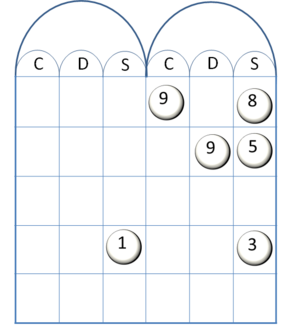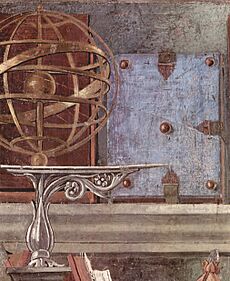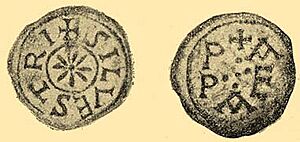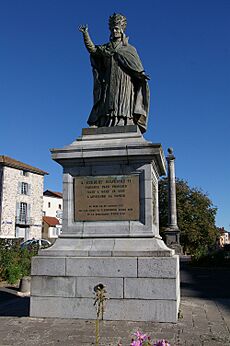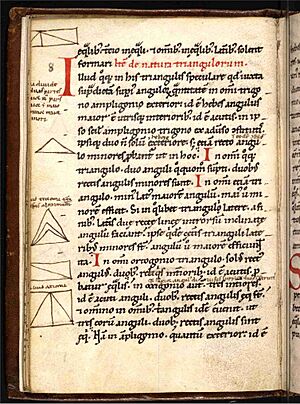Pope Sylvester II facts for kids
Quick facts for kids Pope Sylvester II |
|
|---|---|
| Bishop of Rome | |
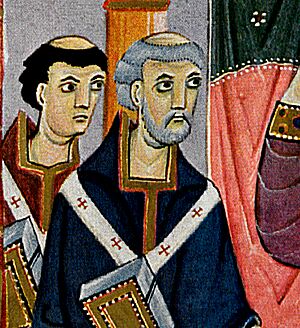
Sylvester, in blue, as depicted in the Gospels of Otto III
|
|
| Church | Catholic Church |
| Papacy began | 2 April 999 |
| Papacy ended | 12 May 1003 |
| Predecessor | Gregory V |
| Successor | John XVII |
| Orders | |
| Consecration | 991 |
| Personal details | |
| Birth name | Gerbertus (Gerbert) |
| Born | c. 946 Belliac (?), Duchy of Aquitaine, France |
| Died | 12 May 1003 (aged c. 57) Rome, Papal States |
| Other Popes named Sylvester | |
Pope Sylvester II, born Gerbert of Aurillac (around 946 – May 12, 1003), was a brilliant scholar and teacher. He became the leader of the Catholic Church as Bishop of Rome and ruled the Papal States from 999 until his death. He was famous for bringing back important scientific knowledge to Western Europe. This included ideas about math and astronomy from the Islamic world and ancient Greece and Rome. He also reintroduced tools like the abacus, the armillary sphere, and the water organ. Many believe he was the first in Christian Europe to introduce the decimal number system, which uses Hindu-Arabic numerals.
Contents
Early Life and Learning
Gerbert was born around 946 in what is now France. His parents wanted him to have a good education. So, they sent him to a Benedictine monastery. There, a monk named Raimund helped him with his studies. Gerbert loved to learn.
Around 963, he joined the Monastery of St. Gerald of Aurillac. In 967, a Spanish count named Borrell II of Barcelona visited the monastery. The abbot asked the count to take Gerbert with him. This way, Gerbert could study mathematics in Catalonia, Spain. He also learned about Arabic knowledge there. He studied in Barcelona and even received Arabic lessons in Seville and Córdoba.
Amazing Scholarly Work
Gerbert studied under Bishop Atto of Vich and at the Monastery of Santa Maria de Ripoll. These places had many books from Muslim Spain, especially from Cordoba. Cordoba was a major center for learning at that time. Its library had thousands of books on science and philosophy. This is where Gerbert first learned about mathematics and astronomy. He was very impressed by the Christian scholars in Spain who knew so much about math and science, just like the great teachers in Islamic schools. This made Gerbert love math and astronomy even more.
The Abacus and Numbers
Gerbert learned about Hindu–Arabic digits. He used this knowledge to improve the abacus, a tool for calculations. He probably didn't use the number zero on his abacus, as it was represented by an empty space.
A historian from the 1100s, William of Malmesbury, said Gerbert got the idea for his abacus from a Moorish scholar. Gerbert's abacus had 27 parts and used 9 number symbols. A shieldmaker in Rheims made 1,000 characters for it from animal horn. Gerbert's student, Richer, said Gerbert could do calculations super fast with his abacus. This was very hard for people back then, who only used Roman numerals. Thanks to Gerbert, the abacus became popular again in Europe in the 11th century.
The Armillary Sphere and Stars
The armillary sphere is an old tool used to show how stars and planets move. It had been forgotten in Europe since ancient Roman times. But Gerbert brought it back to Latin Europe. He learned about it from the advanced Islamic civilization in Spain.
We know about Gerbert's armillary sphere from his letters and from his student Richer. Richer said Gerbert used the armillary sphere to teach math and astronomy. It helped students see how stars move across the night sky.
Richer also explained how Gerbert made the planets easier to see on his armillary sphere. He made a hollow sphere with rings that showed the paths of the planets. He also added "sighting tubes" to some of his spheres. These tubes helped him and his students observe constellations and find the pole star. Gerbert even wrote instructions on how to use these tubes to measure the positions of the North Pole, the Arctic Circle, the Tropic of Cancer, the equator, and the Tropic of Capricorn.
Building a Scientific Library
In 984, Gerbert wrote a letter about starting a big scientific library. He spent a lot of money to build this library. He bought books from many European authors. He also asked monks and abbots across Europe for classical literature. He even got works from older writers like Cicero and Statius. He specifically asked for an astrology book and an arithmetic book. This shows his library had many different types of books.
Church Career
In 969, Gerbert went to Rome with Count Borrell II. There, he met Pope John XIII and Emperor Otto I. The Pope convinced Otto I to hire Gerbert as a teacher for his young son, Otto II.
A few years later, Otto I allowed Gerbert to study at the cathedral school of Rheims. In 973, he became a teacher there. He stayed until 989, except for a short time as the head of the monastery of Bobbio from 981 to 983. When Otto II became emperor in 973, he made Gerbert the abbot of Bobbio. But the monastery was in bad shape, so Gerbert soon went back to Rheims.
After Otto II died in 983, Gerbert got involved in politics. He supported Hugh Capet to become king of France. Hugh became king in 987, ending the old Carolingian line of kings.
In 989, the archbishop of Rheims died. Gerbert was a good choice to take his place. But King Hugh chose someone else, Arnulf. Arnulf was later removed for treason. So, Gerbert was elected archbishop in 991. However, there was a lot of disagreement about this. Pope John XV (985–996) even suspended Gerbert from his church duties for a while. Later, in 995, Arnulf's removal was declared invalid.
Gerbert then became the teacher of Otto III, who was the new emperor. In 998, Pope Gregory V (996–999), who was Otto III's cousin, made Gerbert the archbishop of Ravenna.
With the emperor's support, Gerbert was chosen to be the next pope in 999. He took the name Sylvester II. This name honored Sylvester I (314–335), who was an advisor to Emperor Constantine I.
As pope, Sylvester II worked hard to stop bad practices in the church. He fought against simony (buying or selling church positions) and priests having partners. He believed only good, capable men should become bishops.
In 1001, people in Rome rebelled. This forced Otto III and Sylvester II to leave the city. Otto III tried to get control of Rome back but died in 1002. Sylvester II returned to Rome soon after. He died a little later, on May 12, 1003. Sylvester II is buried in St. John Lateran.
Legacy and Legends
Gerbert of Aurillac was known as a great thinker. He read works by famous writers like Virgil and Cicero. He was also the first French pope.
Many considered Gerbert one of the smartest scientists of his time. He wrote many books about math, geometry, astronomy, and music. He taught these subjects using a system of learning called the quadrivium. In Rheims, he even built a hydraulic-powered organ with brass pipes. It was better than any organ known before! Some people even say Gerbert invented the first mechanical clock in 996. However, it was probably a very fancy water clock, as true mechanical clocks came later.
Cool Stories and Legends
Over time, many stories and legends grew around Gerbert. One famous story comes from an English monk named William of Malmesbury.
According to the legend, Gerbert traveled to Spain to learn more about science. He quickly became smarter than anyone in math, astronomy, and astrology. This is where the stories say Gerbert started learning "dark arts." He supposedly lived with a Saracen philosopher who taught him secret knowledge. Gerbert tried to get all the philosopher's books. There was one special book that held all the dark arts knowledge. Gerbert supposedly tricked the philosopher and stole this book while he slept. He then ran away. The philosopher chased him, using the stars to track him. But Gerbert was smart. He hid by hanging from a wooden bridge. Because he was "between heaven and earth," the magician couldn't see him.
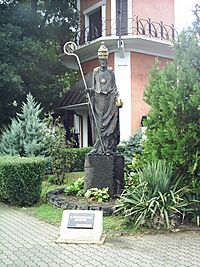
Another legend says Gerbert built a "brazen head." This "robot" head could answer his questions with "yes" or "no." People also said he made a deal with a female demon named Meridiana. She supposedly helped him become pope. Another story says he won the papacy by playing dice with the Devil!
The legend continues that Meridiana (or the bronze head) told Gerbert that if he ever read a Mass in Jerusalem, the Devil would come for him. Gerbert avoided going to Jerusalem. But one day, he read Mass in a church in Rome called "Holy Cross of Jerusalem." Soon after, he got sick and died.
There's a curious legend about his tomb. The inscription on his tomb says his bones will rise at the end of time. But people misread it to mean his bones would rattle just before a pope dies! These are all just old stories, of course.
Honors
Hungary released a special stamp honoring Pope Sylvester II on January 1, 1938. France also honored him with a postage stamp in 1964.
His Writings
Gerbert's writings were collected in a large volume. He likely saved his letters to teach his students how to write well. His books on math and astronomy were mostly guides for his students, not new research.
Here are some of his writings:
- Mathematical writings
- Libellus de numerorum divisione (Book on the Division of Numbers)
- De geometria (On Geometry)
- Regula de abaco computi (Rules for Abacus Calculation)
- Liber abaci (Book of the Abacus)
- Libellus de rationali et ratione uti (Book on Rationality and Its Use)
- Church writings
- Sermo de informatione episcoporum (Sermon on the Training of Bishops)
- De corpore et sanguine Domini (On the Body and Blood of the Lord)
- Letters
- Epistolae ante summum pontificatum scriptae (Letters Written Before Becoming Pope) - This includes letters to the emperor, the pope, and bishops.
- Epistolae et decreta pontificia (Papal Letters and Decrees) - Letters to abbots and bishops.
See also
 In Spanish: Silvestre II para niños
In Spanish: Silvestre II para niños
- List of Roman Catholic scientist–clerics
- Barcelona astrolabe


